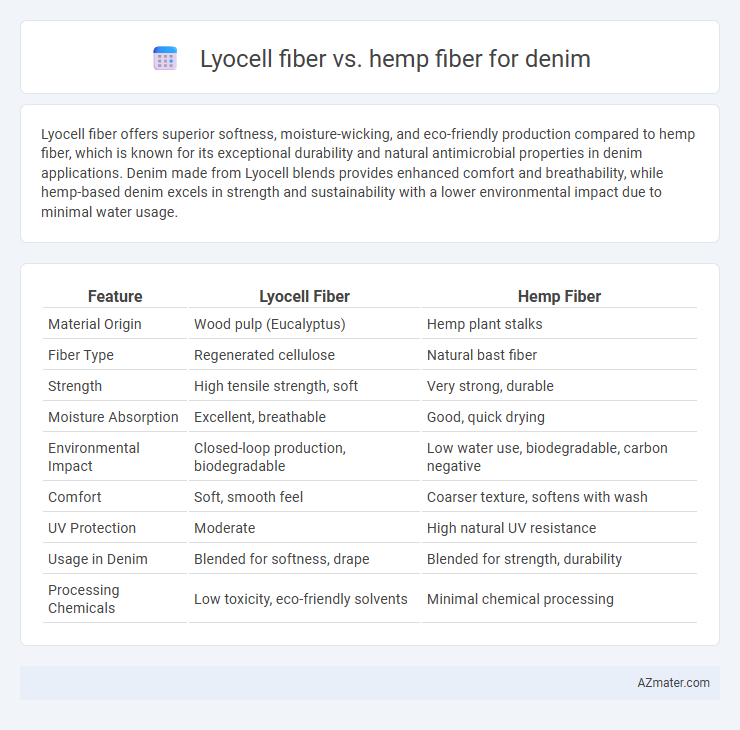Lyocell fiber offers superior softness, moisture-wicking, and eco-friendly production compared to hemp fiber, which is known for its exceptional durability and natural antimicrobial properties in denim applications. Denim made from Lyocell blends provides enhanced comfort and breathability, while hemp-based denim excels in strength and sustainability with a lower environmental impact due to minimal water usage.
Table of Comparison
| Feature | Lyocell Fiber | Hemp Fiber |
|---|---|---|
| Material Origin | Wood pulp (Eucalyptus) | Hemp plant stalks |
| Fiber Type | Regenerated cellulose | Natural bast fiber |
| Strength | High tensile strength, soft | Very strong, durable |
| Moisture Absorption | Excellent, breathable | Good, quick drying |
| Environmental Impact | Closed-loop production, biodegradable | Low water use, biodegradable, carbon negative |
| Comfort | Soft, smooth feel | Coarser texture, softens with wash |
| UV Protection | Moderate | High natural UV resistance |
| Usage in Denim | Blended for softness, drape | Blended for strength, durability |
| Processing Chemicals | Low toxicity, eco-friendly solvents | Minimal chemical processing |
Introduction to Sustainable Denim Fibers
Lyocell and hemp fibers are prominent sustainable options transforming denim production by reducing environmental impact. Lyocell, derived from sustainably sourced wood pulp, offers a smooth texture, superior moisture absorption, and biodegradability, making it ideal for eco-friendly denim blends. Hemp fiber boasts exceptional durability, fast growth with low water requirements, and natural resistance to pests, contributing to a reduced carbon footprint in sustainable denim manufacturing.
Overview of Lyocell Fiber: Properties & Production
Lyocell fiber, derived from sustainably sourced wood pulp through a closed-loop solvent spinning process, offers exceptional softness, breathability, and moisture-wicking properties ideal for denim applications. Its high tensile strength and durability enhance fabric performance while maintaining environmental sustainability due to minimal chemical waste and water usage. Compared to hemp fiber, lyocell provides superior drape and comfort, making it a preferred choice for premium denim blends focused on sustainability and wearability.
Overview of Hemp Fiber: Properties & Production
Hemp fiber, derived from the stalks of the Cannabis sativa plant, is renowned for its exceptional durability, breathability, and natural antimicrobial properties, making it a sustainable choice for denim fabric. The production process involves retting, decortication, and combing, which efficiently extract long, strong fibers suitable for blending with cotton or lyocell to enhance denim's strength and eco-friendliness. Its high tensile strength, moisture-wicking ability, and resistance to UV light contribute to denim garments that are both comfortable and long-lasting, positioning hemp as a valuable alternative in sustainable textile manufacturing.
Environmental Impact: Lyocell vs Hemp
Lyocell fiber, derived from sustainably managed eucalyptus plantations, offers a closed-loop production process that recycles water and solvents, significantly reducing environmental pollutants compared to conventional textile manufacturing. Hemp fiber, known for its rapid growth and minimal need for pesticides or synthetic fertilizers, enhances soil health through phytoremediation and requires less water than cotton, making it highly eco-friendly for denim production. Both fibers present sustainable alternatives to traditional denim materials, with Lyocell excelling in chemical reuse and softness, while hemp leads in regenerative agriculture and carbon sequestration.
Performance & Durability in Denim Applications
Lyocell fiber offers superior moisture absorption and breathability compared to hemp, enhancing comfort and wearability in denim applications. Hemp fiber provides exceptional tensile strength and abrasion resistance, contributing to long-lasting durability and structural integrity in heavy-duty denim garments. Combining lyocell's softness with hemp's toughness creates a balanced denim fabric that excels in both performance and durability for diverse clothing needs.
Comfort and Wearability: Lyocell vs Hemp
Lyocell fiber in denim offers exceptional softness, moisture-wicking properties, and breathability, enhancing comfort during extended wear. Hemp fiber, while durable and naturally resistant to abrasion, tends to be coarser and less flexible, which can impact overall comfort and ease of movement. Denim blended with Lyocell provides a smoother, more breathable fabric, whereas hemp-based denim is more rugged but may require additional processing to improve softness for better wearability.
Aesthetic Differences in Denim Appearance
Lyocell fiber in denim produces a smooth, silky finish with a subtle sheen, enhancing color vibrancy and depth for more refined aesthetics. Hemp fiber offers a coarse texture and natural irregularities that create a rugged, vintage look with enhanced durability and organic appeal. The aesthetic differences between Lyocell and Hemp denim are defined by Lyocell's uniform softness and Hemp's textured, raw character.
Cost and Availability for Manufacturers
Lyocell fiber generally costs more than hemp fiber due to its complex manufacturing process, which involves solvent spinning that increases production expenses. Hemp fiber is more readily available and sustainable, with established large-scale farming in regions like China and Canada, making it a cost-effective option for denim manufacturers. While Lyocell offers softness and durability, manufacturers often prefer hemp for denim when prioritizing lower material costs and consistent supply chains.
Market Trends: Consumer Preferences & Brand Adoption
Lyocell fiber is gaining significant traction in denim manufacturing due to its sustainability, softness, and biodegradability, appealing to eco-conscious consumers prioritizing comfort and environmental impact. Hemp fiber also sees increased adoption for denim because of its durability, natural antimicrobial properties, and low water usage, aligning with brands targeting rugged, sustainable fashion. Market trends show a growing preference for blends combining Lyocell and Hemp, leveraging the strengths of both fibers to meet diverse consumer demands and enhance brand sustainability credentials.
Conclusion: Choosing the Right Fiber for Denim
Lyocell fiber offers superior softness, breathability, and moisture-wicking properties, making it ideal for comfortable, high-performance denim. Hemp fiber provides exceptional durability, eco-friendliness, and UV resistance, suitable for rugged, sustainable denim products. Selecting the right fiber depends on prioritizing either comfort and sustainability with Lyocell or strength and environmental resilience with Hemp.

Infographic: Lyocell fiber vs Hemp fiber for Denim
 azmater.com
azmater.com